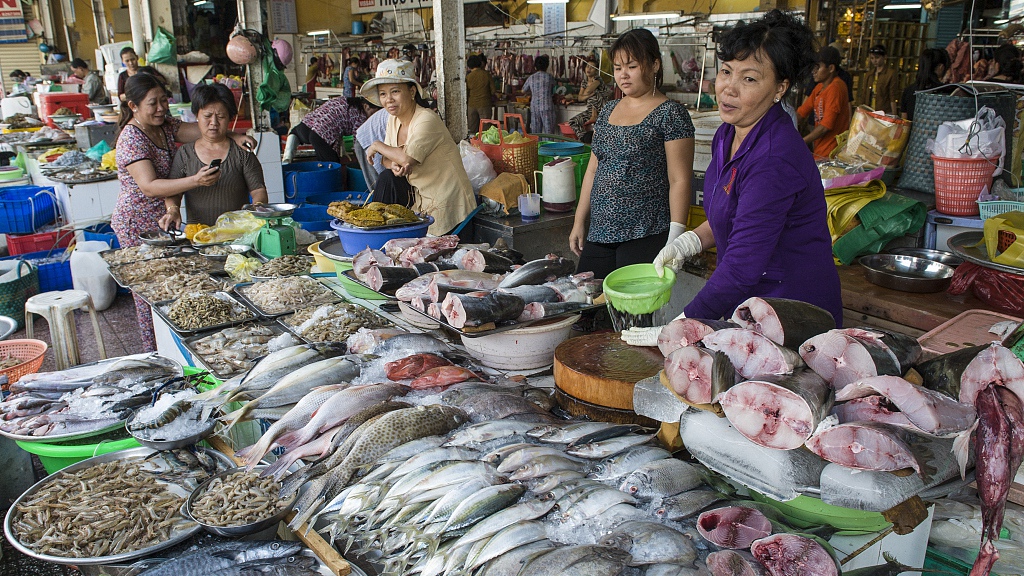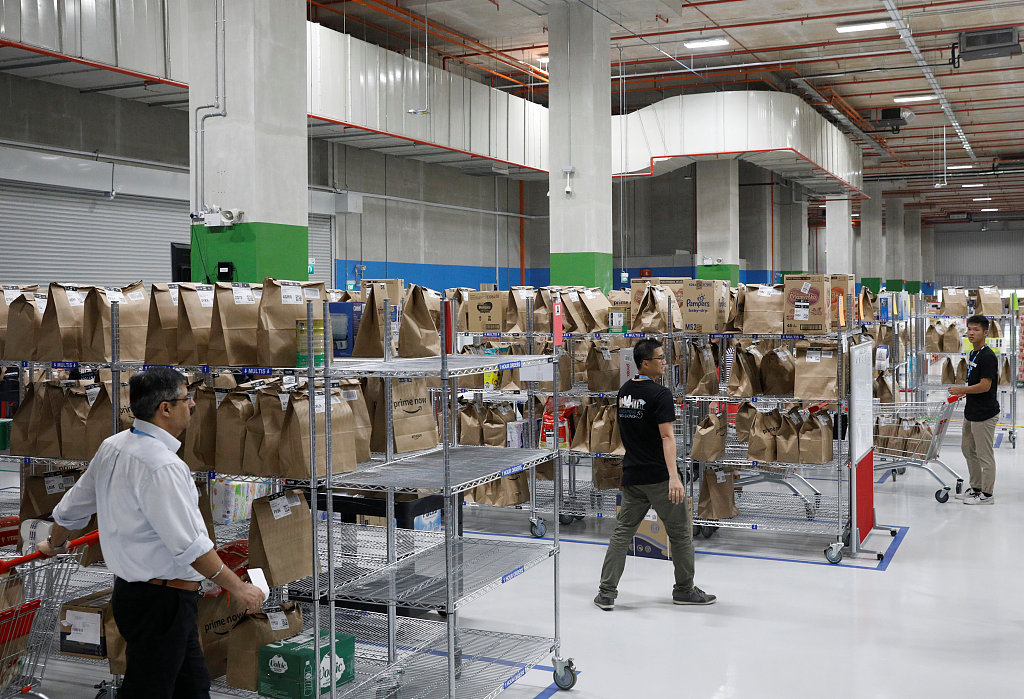
Vietnamese women shop for fish at a market in Ho Chi Minh City, Vietnam. /CFP
Vietnamese women shop for fish at a market in Ho Chi Minh City, Vietnam. /CFP
Editor's note: Alexander Ayertey Odonkor is an economic consultant, chartered financial analyst and a chartered economist with an in-depth understanding of the economic landscape of countries in Asia and Africa. The article reflects the author's opinions and not necessarily the views of CGTN.
Highlights of a study conducted by Google and Temasek suggest that Southeast Asia's digital economy was worth 31 billion U.S. dollars in 2015 and could reach a projected value of 200 billion U.S. dollars by 2025. However, this projection could be a substantial underestimate in a case where the region reaches a consensus on data and digital commerce management.
The forecasted growth will be driven largely by the increasing activity of online travels, electronic commerce, online media and the required investments of about 40 to 50 billion U.S. dollars over the period. Currently, Southeast Asia has adequate telecommunication infrastructure that provides reliable services and affordable smartphones to the people in the region.
In 2018, the region was home to more than 350 million internet users across Malaysia, Singapore, the Philippines, Vietnam, Indonesia and Thailand, representing an additional 90 million internet users when compared to 2015.
With about 90 percent of the population connected to the internet via smartphones, Southeast Asia's internet subscribers are the most engaged in the world. Data from Hootsuite indicates that internet users in Thailand spend the most time on the internet, more than any other country in the world. Whiles internet users in Thailand spend four hours and 56 minutes per day on mobile internet, other internet users in Malaysia, the Philippines and Indonesia have also been ranked among the world's top ten most engaged internet users, as these countries in Southeast Asia spend close to four hours a day using the mobile internet.
Compared to other internet users in the United Kingdom and the United States, who spend a little over two hours per day, and internet users in Germany, Japan and France, who spend approximately one hour and 30 minutes, mobile internet users in Southeast Asia are the most active in the world.
As the population of internet users continues to soar, the e-commerce market has also been growing in recent times. An increasing number of internet users in Southeast Asia frequently order products on e-commerce platforms, with e-commerce revenue estimated to exceed 20 billion in 2020.
Frost & Sullivan revealed that, in 2015, revenue generated from e-commerce in the region amounted to more than 11 billion U.S. dollars with Malaysia, Thailand and Singapore being the major contributors for the boost in revenue.
In spite of the growth in e-commerce in the region, online retail constitutes less than 2.5 percent of Southeast Asia's entire retail and accounts for only one percent of the total retail sales. Considering the size of Southeast Asia's market, this is quite low when compared to Europe and North America, where online retail accounts for about six percent to eight percent of the total revenue generated from retail.
Three main challenges hinder the region's e-commerce market from reaching its full potential: limited logistics, excessive reliance on cash on delivery payments and a lack of customer familiarity and trust. Limited logistics has been a major drawback for e-commerce in the region. In 2016, Southeast Asia scored 3.14 out of five on the World Bank's Logistics Performance Index. Meanwhile, countries in the region such as Myanmar, the Philippines and Vietnam ranked 113, 71 and 64 respectively out of 160 countries.

Employees work at Amazon's Prime Now fulfillment center in Singapore July 27, 2017. /CFP
Employees work at Amazon's Prime Now fulfillment center in Singapore July 27, 2017. /CFP
For e-commerce providers, the inability to acquire a suitable capacity to deliver products to customers efficiently has been a snag in carrying out transactions as lack of appropriate warehouses, unfriendly customs policies and poor last-mile infrastructure have increased the risk exposure of e-commerce businesses.
To overcome this barrier, e-commerce companies will have to invest adequately to achieve set objectives, as the cost involved in providing a long term solution is usually high. A typical example is the case of online shopping platform Shop.com.mm in Myanmar, which incurs about 50 percent of the company's overall operating cost in working closely with the Myanmar Post and other private logistics companies to deliver improved e-commerce services.
Again, the e-commerce market in Southeast Asia is characterized by cash on delivery payment. More than 74 percent of transactions are carried out by exchanging physical cash for products at the time of delivery, which poses many risks for e-commerce providers.
Apart from the fact that cash on delivery payment in some cases allows customers to return products without making payments, this mode of payment increases the operating cost of e-commerce companies, as the manual handling of cash is more expensive when compared to the alternative merchant discount rate offered by digital platforms. Cash on delivery payment is widely used because about 73 percent of Southeast Asia's population do not have bank accounts.
With the exception of Thailand, less than 35 percent of adults in all other countries in the region have registered accounts at financial institutions, representing a low penetration rate for credit cards and debit cards. E-commerce providers can adopt the services of mobile money providers to augment their efforts in mitigating risk exposure; with approximately seven agents per 10,000 customers, mobile money services could prove to be a viable resource for e-commerce companies.
Apart from providing a comparatively less expensive payment solution, e-commerce providers could partner with mobile money providers to improve product delivery through the "order and pick up" model at mobile money agent outlets.
Also, lack of customer familiarity and trust is a challenge for e-commerce providers, as the region is known for high levels of internet fraud, which has made e-commerce platforms an unattractive destination for a large section of the population in Southeast Asia.
To overcome this barrier, it's imperative for e-commerce providers to educate the general public by relying on marketing strategies, such as promotional discounts that could enhance customers' familiarity and trust when patronizing the services of e-commerce companies.
Additionally, regulatory bodies should ensure that online shopping platforms and other information infrastructures are completely secured to detect malicious attempts on online shopping platforms and alleviate cyber fraud. If these measures are implemented effectively, it will protect consumers, build trust in e-commerce platforms and create sustainable digital economies in Southeast Asia.
(If you want to contribute and have specific expertise, please contact us at opinions@cgtn.com.)